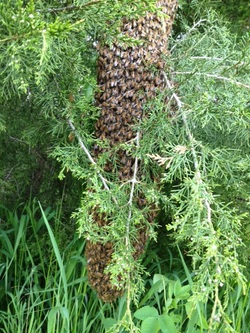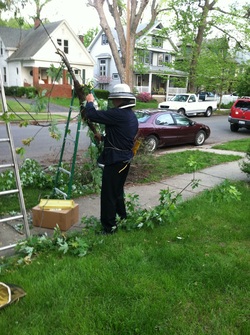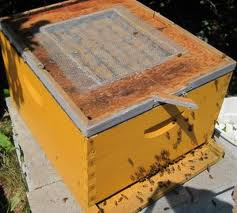
Bee sure to check out this site's write up on swarms (here), if you see one and don't know what to do. If you are a beekeeper, here's the actions you should take:
So what do you do if you want to capture the swarm?
Gather.
1. Get a swarm box ready. Put in some old comb and some fresh foundation, as these bees will be ready to build comb. You'll put the swarm in this box. While I use a modified hive body, in a pinch a good cardboard box will do.
2. Put the following in a bucket just in case: bee brush, tree saw, branch loppers, pruners.
3. Bring your ladder.
4. Bring your gloves and veil and smoker: Even though swarms are generally gentle, I like to get fully "dressed" just in case the swarm is fractious.

Time to act. The goal here is to grab the bees without injuring them, and keeping the queen in the center of the cluster. That way all the bees will guide in on her presence in the box.
Once you have everything in place near the swarm, take a few moments to strategically place your swarm box under the cluster.
1. Clip small limbs that are in the way of directly accessing the bees.
2. If possible, cut the main branch and place bees and branch directly into the box.
3. In the alternative, move the box directly under the cluster of bees and give the branch a solid shake, such that the majority of the cluster will drop into the box. Assuming you got the majority of the bees to fall in the box, loosely cover the top of the box and let the whole operation rest for a few minutes.
4. You'll know fairly quickly whether you got the queen or not, as the remaining bees will head to the box (if you got the queen) or back to the cluster (if you didn't).
5. Once you have them all, cover the top completely, and once nightfall comes, get ready to move the hive.

Place the bees in their new home.
Ideally you will move the hive to its new location, at least 2 miles beyond their original location.
1. Prepare the hive body location so you can move the bees into their new home with limited disruption.
2. Lift the frames of bees out of the swarm box and place into the hive body.
3. Shake or brush the remainder of the bees into the front of the hive. The bees will then fly to where the queen is located and set up their new digs.
4. Feed the new swarm a 1:1 sugar water to help them produce a lot of wax quickly. Do this especially if the weather looks nasty for the coming days.
5. Watch for development and growth of the hive. Recall that it is most likely that this swarm's queen is "old" and may need to be replaced sometime in the fall. Likewise, check the hive in a few days, for eggs, mites, and general health.
Well done!
As always, there is always more to learn around the hive.
See you there soon!
tim
 RSS Feed
RSS Feed